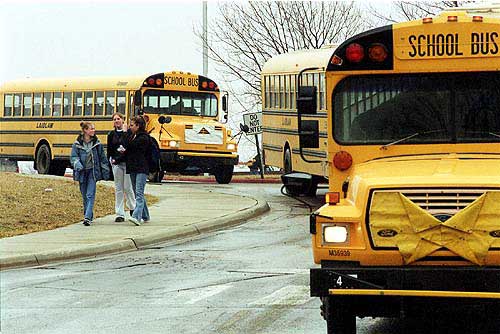Back to basics?
Budget shortfall means cuts for Kansas school districts
When buying a car, it is necessary to make decisions about what features it will include. Everyone wants a car that will provide necessary and basic transportation. But each buyer will have different priorities, both about the basics and the extras. And some options aren’t really choices; they’re grouped features that must be purchased as a package and can’t be selectively removed.
Leather interiors or mega stereo system? Stick shift or automatic? Few of the choices are easy, and none can be labeled right or wrong on a universal level because it will be settled differently for individuals depending on what they want.

Because of a projected 26 million state budget shortfall, the Lawrence school district is looking for areas to cut its budget. One proposal calls for charging for bus service for students who live within 2 miles of their school. Here, buses transport students from Broken Arrow and South Junior High school.
Right now, the Kansas Legislature is meeting to decide difficult questions on next year’s state budget, which is projected to be short by at least $426 million. This could translate to $5 million in cuts for the Lawrence school district.
Last week, lawmakers rejected a bill to rescind money already allocated for the present fiscal year. That would have been like your parents giving you a set amount of allowance with which to buy lunch at school, pay for gas, purchase clothes and hang out with your friends for the school year, and then, just after second semester starts, asking for some of it back.
Your budgeting would be blown. Not only would you lose the fun stuff, but you might not be able to pay for the basics.
The bill is dead, but the reprieve is only temporary. The crisis has merely been postponed to the next budget year, and tough decisions still have to be made.
One of the immediate and direct effects this situation will have on children is the way they go to school. While exact figures are still being determined, school districts like Lawrence’s already know that decisions will have to be made about where and how much to cut spending.

To save money, the Lawrence school district may allow larger class sizes. This would most likely affect classes at the secondary level, including those at Free State High School, pictured here.
Up for discussion
Several initial possibilities for cuts to the Lawrence school district’s budget have been discussed.
One is in busing. School districts are only required to bus those that live 2 miles or more from their school, but the Lawrence school district does much more. One proposal is to either cut back on the extra busing service or charge those who live within 2 miles to continue using the buses. Inability to pay would be taken into consideration, as with programs like subsidized lunches.
Another cut will affect the high schools: It is possible that there will be no zero hour next year. This would prevent students from taking seven classes or from taking the zero hour through fifth hour schedule and getting out early, which many students with jobs enjoy. This will also make graduating early almost impossible.
There have been suggestions to reduce the variety of classes, such as additional English classes offered at the high school level. Allowing larger class sizes is also a possibility. This is more likely to happen on a junior high or high school level.
Another possibility is to cut funding for staff development for a year. Apparently this has been done in other districts as a temporary measure. Even freezing teachers’ wages for a year is a possibility. It has been argued that this would be unpopular and difficult, but proponents say it may be preferable to eliminating positions.
Other suggested cuts are more difficult or even impossible. This is because of federal mandates, such many special education programs, that are not fully funded from outside the district but the district is legally responsible for maintaining. This means that a large proportion of the budget must be spent on services that legally must be provided. The school district has no choice on this and can’t make cuts in these places.
Beyond the basics
If we go back to thinking of buying the basic car model of education, what must be there to provide that basic education? Basics have expanded from the past. Are the arts among the basics? Athletics?
We could return to reading, writing and arithmetic, but today’s world demands much more than the world surrounding one-room schoolhouses.
How much of today’s educational services can be cut without affecting what is necessary for current society? That would mean another round of intense debates about the place of education in our world.
If we did compromise on a basic model of education, it might mean setting a common right to certain services and those beyond that have to be paid for with extra fees. Those who participate in art, athletics, debate or forensics might have to pay some portion of the program’s cost.
Youths look to adults as models to learn how to make hard decisions. With age-appropriate information, children can begin understanding how and why decisions are made.
This is a chance for the adults of the community to show how decisions are made when something must be sacrificed. Will they battle over their own turf? Or will they manage to come to some painful but necessary compromises that affect all somewhat but none disproportionately?
Just like the car, where only so many features can be afforded, decisions are necessary. The best ones will be made when everyone works together to make them.
Rebekah Zemansky is a senior at Lawrence High School.

